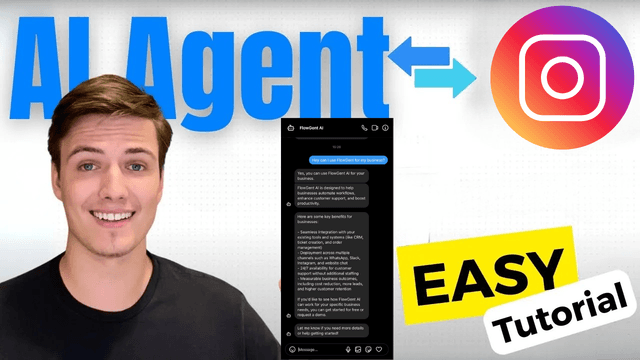Connecting an AI agent to a SQL database opens up a world of possibilities for interacting with your data in real-time. With FlowGent AI, you can seamlessly link AI agents to popular SQL databases like PostgreSQL and MySQL. If you haven't set it up yet, see how to deploy an AI agent on your website. This blog post summarizes a video tutorial that walks you through the process using FlowGent AI. Whether you want to chat with your data, automate repetitive tasks, or integrate database queries into tools like Slack, FlowGent AI makes it simple and efficient.
Possible Use Cases for Connecting AI Agents to SQL Databases
Before diving into the steps, let’s explore some practical applications:
-
Chat with E-commerce Orders Data: Ask your AI agent to retrieve order details or analyze sales trends directly from your PostgreSQL or MySQL database.
-
Automate Marketing Content Updates: Use the AI to pull data and update marketing materials based on the latest database insights.
-
Integrate with Slack for Database Queries: Enable your team to query PostgreSQL or MySQL databases via Slack using natural language commands.
Step-by-Step Guide: How to Connect an AI Agent to a SQL Database
1. Setting Up a SQL Database Connection in FlowGent AI (PostgreSQL & MySQL)
To get started, sign up for FlowGent AI and add a SQL database connection. FlowGent AI supports both PostgreSQL and MySQL, so you can choose the database that fits your needs. Enter your database credentials, and FlowGent AI will establish a secure connection.
2. Creating and Configuring an AI Agent in FlowGent AI
Next, create a new AI agent within FlowGent AI. Give it a name (e.g., “OrderBot”) and define a trigger, such as starting a chat session. This agent will serve as your interface to the PostgreSQL or MySQL database.
3. Adding a SQL Query Tool to Your AI Agent
Add a SQL query tool to your agent in FlowGent AI. Link this tool to your PostgreSQL or MySQL database connection. This allows the AI to execute queries and fetch data based on your instructions. For more information on ingesting and training your AI with custom data, see how to train ChatGPT with your data.
4. Defining Core Instructions for Your AI Agent
Provide clear instructions to your agent, either via voice or text. For example, you might instruct it to “retrieve all orders from the past week” or “summarize sales data.” These instructions guide how the agent interacts with your PostgreSQL or MySQL database.
5. Testing Your AI Agent with a SQL Query
Finally, test your setup with a sample query. Ask your agent something simple, like “Show me the top 5 customers by sales,” and verify that it retrieves the correct data from your PostgreSQL or MySQL database. Adjust as needed to ensure smooth performance.
Recommended
We recommend watching the video below to see a visual walktrough of the process! If you have any questions feel free to chat to the agent inside the app and it can help or get you in contact with our team if it doesn't know!
Good to know
You can define scopes for your agent, this makes sure that it does not access tables or data it shouldn't. This gives you the flexibility of an AI Agents without the certainty of a workflow.
FAQ
1. What does “connect an AI agent to SQL” actually mean?
It’s plugging a FlowGent AI agent straight into your database (PostgreSQL, MySQL, etc.) so the agent can read or write tables by following your plain‑English prompts or scripted instructions.
2. How do I keep that connection secure?
- Give the agent a least‑privilege DB user.
- Force TLS/SSL on the connection string.
- Park credentials in a secrets manager, not your codebase.
- Lock down tables with FlowGent’s scope controls or a query whitelist.
3. How do I avoid sluggish, AI‑generated queries?
- Add the right indexes before the agent goes live.
- Use connection pooling so every chat round‑trip doesn’t spawn a new connection.
RAG vs Direct SQL vs API Route — When to Pick What
| Scenario | RAG (vector search + LLM) | Direct SQL connection | Custom API route |
|---|---|---|---|
| Best for | Unstructured docs, knowledge bases, Q&A on long text. | Live, structured data (orders, metrics) where accuracy is critical. | Business logic that lives outside the DB or spans multiple services. |
| Data shape | Free‑form text chunks stored in a vector DB. | Tabular rows/columns in MySQL, Postgres. | JSON payloads defined by the service. |
| Latency profile | Medium (embed search + generation). | Low (single SQL round‑trip). | Medium–high (HTTP hops + service logic). |
| Consistency | Eventual – depends on refresh cadence. | Instant—queries run on the source of truth. | Depends on API caching and versioning. |
| Security surface | Vector DB perms + prompt filtering. | DB roles, network ACLs, SQL scopes. | Auth tokens, rate limits, input validation. |
| Coding effort | Load docs → embed → build RAG chain. | Wire DB connector, set scopes. | Stand‑up REST/GraphQL endpoint, docs, SDK. |
| When to skip it | You need exact numbers or real‑time rows. | You need heavy business logic or cross‑system joins. | You just need a quick analytic query the DB can answer directly. |
Conclusion
Connecting an AI agent to a SQL database using FlowGent AI is straightforward and powerful. With support for PostgreSQL and MySQL, you can unlock a range of use cases, from chatting with your data to automating workflows. Check out the full video tutorial below for a detailed walkthrough, and try it yourself with FlowGent AI!
Watch the Video Tutorial
Here’s the embedded YouTube video to guide you through the process:

